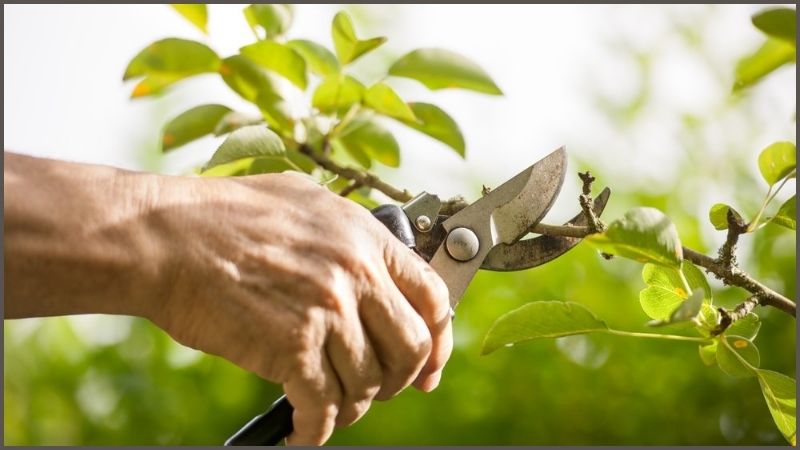Proper tree care is essential for maintaining the health, longevity, and aesthetic value of trees in any landscape. Trees are vital to our environment, offering shade, beauty, and support for wildlife. However, to ensure their well-being, it’s crucial to follow specific tree care techniques that address their diverse needs. By understanding and implementing these techniques, you can prevent common issues such as disease, pest infestations, and physical damage. In this blog, we will explore eight essential tree care techniques that will help your trees thrive for many years. Whether you’re a homeowner, landscaper, or arborist, these practices will enhance the health and longevity of the trees you care for.
8 Proper Tree Care Techniques for Longevity
1. Regular Pruning

Regular pruning is a fundamental tree care technique that promotes healthy growth and prevents structural issues. Pruning involves removing dead, damaged, or diseased branches, which helps to improve the tree’s overall structure and appearance. It also allows for better air circulation and sunlight penetration, reducing the risk of fungal infections and pest infestations.
When pruning, it’s important to use clean, sharp tools to make precise cuts. Avoid removing more than 25% of the tree’s canopy in a single pruning session to prevent stress. Pruning should be done during the tree’s dormant season, typically late winter or early spring, to minimize the impact on its growth. Proper pruning techniques not only enhance the tree’s aesthetics but also contribute to its long-term health and longevity.
2. Adequate Watering
Adequate watering is a crucial aspect of tree care that directly influences a tree’s health and longevity. Trees require a consistent water supply, especially during their formative years and periods of drought. Proper watering helps to ensure that the tree’s roots receive the necessary moisture to support healthy growth and development.
When watering trees, it’s essential to apply water deeply and infrequently, allowing the soil to dry slightly between watering sessions. This encourages deep root growth and improves the tree’s drought resistance. Avoid watering too frequently or shallowly, as this can lead to root rot and other issues. Mulching around the base of the tree can also help retain soil moisture and regulate temperature.
3. Fertilization

Fertilization is another important tree care technique that supports the growth and vitality of trees. Trees need a range of nutrients to thrive, including nitrogen, phosphorus, and potassium. Fertilizing helps to replenish these nutrients in the soil, especially if the tree is growing in nutrient-poor conditions.
When fertilizing, choose a balanced fertilizer that matches the specific needs of the tree species and its growing environment. It’s best to apply fertilizer in the early spring or late fall when the tree is not actively growing. Avoid over-fertilizing, as excessive nutrients can lead to rapid, weak growth and increase susceptibility to pests and diseases. Regular, appropriate fertilization contributes to a tree’s long-term health and resilience.
Read Also: 10 Tree Care And Maintenance Tips For Fruit-Bearing Trees
4. Proper Mulching
Proper mulching is a vital tree care technique that benefits tree health by improving soil conditions and reducing competition from weeds. Mulch helps to retain soil moisture, regulate soil temperature, and provide nutrients as it decomposes. It also protects the tree’s root system from physical damage and reduces the risk of lawnmower and trimmer injuries.
When mulching, use organic materials such as wood chips, bark, or compost. Apply a layer of mulch about 2-4 inches thick, ensuring it extends out to the drip line of the tree. Avoid piling mulch directly against the trunk, as this can create a moist environment conducive to fungal growth and rot. Proper mulching practices support healthy root development and overall tree care vitality.
5. Pest and Disease Management

Effective pest and disease management is crucial for maintaining tree health and longevity. Trees are susceptible to a range of pests and diseases that can weaken or kill them if not properly managed. Regular monitoring and early intervention are key to preventing and addressing these issues.
To manage pests and diseases, start by regularly inspecting your trees for signs of trouble, such as unusual spots, leaf discoloration, or insect activity. Use integrated pest management (IPM) techniques that combine cultural, physical, and biological controls. Avoid using excessive chemical treatments, as they can harm beneficial organisms and disrupt the ecosystem. Proper pest and disease management ensures that trees remain healthy and resilient.
6. Soil Aeration
Soil aeration is an important tree care technique that helps improve root health and overall tree growth. Compacted soil can restrict root development, limit oxygen availability, and hinder water infiltration. Aerating the soil helps to alleviate compaction, allowing roots to access essential nutrients and moisture more effectively.
Aeration can be achieved through various methods, such as using a garden fork or a mechanical aerator to create small holes in the soil. It’s best to aerate the soil during the tree’s dormant season to minimize disruption. Additionally, adding organic matter, such as compost, can improve soil structure and promote healthy root growth. Regular soil aeration supports the long-term health and stability of trees.
7. Tree Support Systems
Tree support systems are essential for young or newly planted trees to ensure they grow straight and strong. Support systems help stabilize the tree care, reducing the risk of damage from wind or other environmental factors. Proper support is particularly important for trees with weak root systems or those planted in challenging conditions.
Common support systems include staking and guying. Staking involves using wooden or metal stakes to secure the tree, while guying uses ropes or cables to provide additional support. It’s important to adjust the support system as the tree grows and to remove it once the tree is established and strong enough to stand independently. Proper use of tree support systems contributes to healthy, well-formed trees.
8. Correct Planting Techniques
Correct planting techniques are fundamental to ensuring the long-term health and longevity of trees. Planting a tree properly from the beginning sets the stage for strong growth and reduces the likelihood of future problems. Key aspects of correct planting include choosing the right location, preparing the soil, and planting at the correct depth.
When planting, select a location that provides adequate sunlight, space, and soil conditions for the tree species. Prepare the planting hole by digging it wider than the root ball and incorporating organic matter to improve soil structure. Plant the tree at the same depth it was growing in the nursery, ensuring the root flare is visible at the soil surface. Proper planting techniques establish a strong foundation for the tree’s future growth and vitality.
Conclusion
Implementing proper tree care techniques is essential for ensuring the longevity and health of your trees. From regular pruning and adequate watering to effective pest management and correct planting, each technique plays a crucial role in supporting your tree’s growth and resilience. By following these practices, you not only enhance the aesthetic value of your landscape but also contribute to a healthier environment. Remember, the key to successful tree care lies in understanding and addressing the specific needs of each tree. By applying these eight essential techniques, you can enjoy the benefits of robust, thriving trees for many years to come.
FAQs
How often should I prune my trees?
Regular pruning should be done annually or as needed. Focus on removing dead or diseased branches and maintaining the tree’s structure. Avoid heavy pruning, especially during the growing season.
What is the best time to water my trees?
Water trees early in the morning or late in the afternoon to minimize evaporation. Ensure the soil is moist but not waterlogged. Deep watering is more effective than frequent shallow watering.
